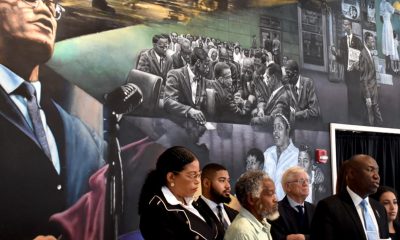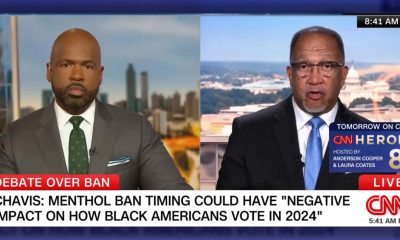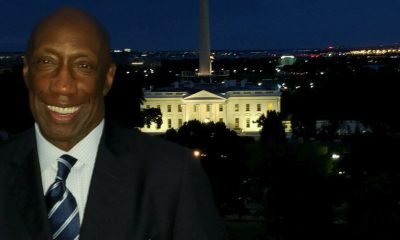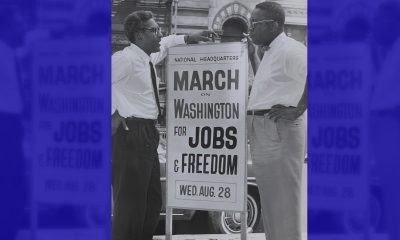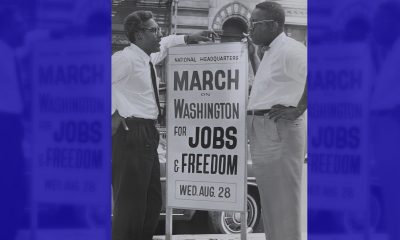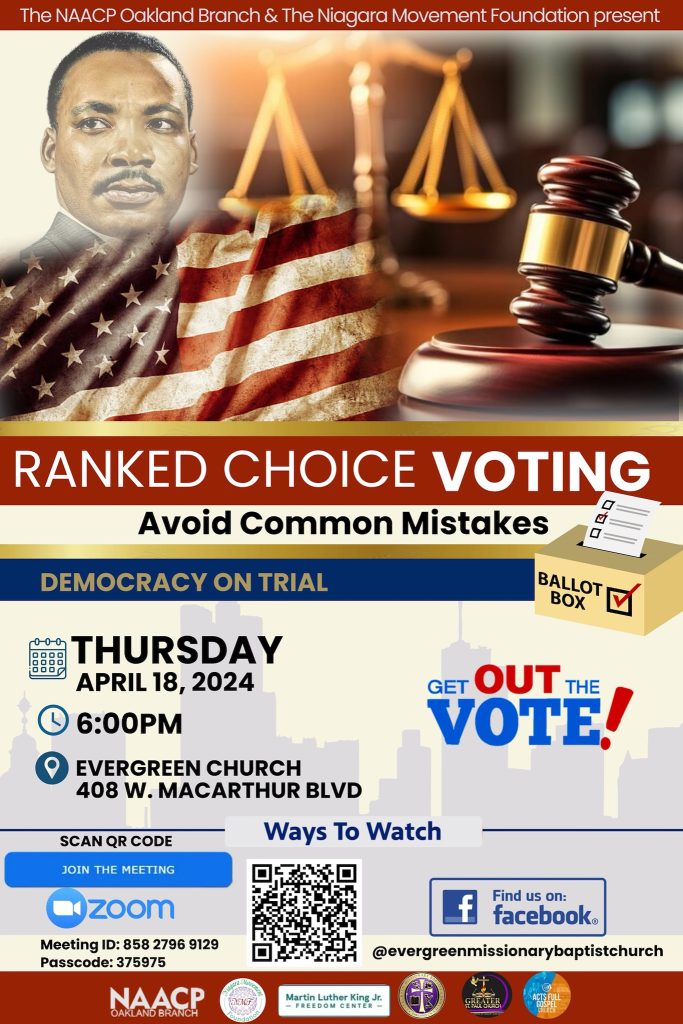Business
Body-Camera Maker Has Financial Ties to Police Chiefs

In this photo taken Thursday, Feb. 19, 2015, Steve Tuttle, vice president of communications for Taser International, demonstrates one of the company’s body cameras for The Associated Press during a company-sponsored conference hosted by Taser at the California Highway Patrol Headquarters in Sacramento, Calif. (AP Photo/Rich Pedroncelli)
RYAN J. FOLEY, Associated Press
IOWA CITY, Iowa (AP) — Taser International, the stun-gun maker emerging as a leading supplier of body cameras for police, has cultivated financial ties to police chiefs whose departments have bought the recording devices, raising a host of conflict-of-interest questions.
A review of records and interviews by The Associated Press show Taser is covering airfare and hotel stays for police chiefs who speak at promotional conferences. It is also hiring recently retired chiefs as consultants, sometimes just months after their cities signed contracts with Taser.
Over the past 18 months, Taser has reached consulting agreements with two such chiefs weeks after they retired, and it is in talks with a third who also backed the purchase of its products, the AP has learned. Taser is planning to send two of them to speak at luxury hotels in Australia and the United Arab Emirates in March at events where they will address other law enforcement officers considering body cameras.
The relationships raise questions of whether chiefs are acting in the best interests of the taxpayers in their dealings with Scottsdale, Arizona-based Taser, whose contracts for cameras and storage systems for the video can run into the millions of dollars.
As the police chief in Fort Worth, Texas, successfully pushed for the signing of a major contract with Taser before a company quarterly sales deadline, he wrote a Taser representative in an email, “Someone should give me a raise.”
The market for wearable cameras that can record arrests, shootings and other encounters has been growing fast since the killing last August of 18-year-old Michael Brown by a police officer in Ferguson, Missouri. President Barack Obama has proposed a $75 million program for departments to buy the cameras to reduce tensions between officers and the communities they serve.
City officials and rival companies are raising concerns about police chiefs’ ties to Taser, not only in Fort Worth but in such cities as Albuquerque, New Mexico, and Salt Lake City.
“Department heads need to be very careful to avoid that type of appearance of an endorsement in a for-profit setting,” said Charlie Luke, a Salt Lake City councilman. “It opens up the opportunity for competitors of these companies to essentially do what we’re seeing here — complaining about that public process.”
He said he was surprised when he learned last year that the city’s police department had purchased Taser cameras using surplus money, bypassing the standard bidding process and City Council approval. The department declined to say how much it has spent acquiring 295 body cameras and Taser’s Evidence.com video storage program and hasn’t responded to a month-old public records request.
The city’s police chief, Chris Burbank, said that his relationship with Taser, which includes company-paid travel to Taser-sponsored conferences, is appropriate. He recently recorded at the company’s request a promotional video in which he praised Evidence.com.
Burbank said he does not receive speaking fees and believes he hasn’t violated a city code prohibiting paid product endorsements on public time. He said he accepts Taser’s speaking invitations to promote the best ways of using body cameras. But Luke, the city councilman, questioned what value Salt Lake City gets from Burbank’s trips.
A Taser spokesman said the company has no control over how cities decide to award contracts. Taser says early adopters of technology are the best ones to discuss its benefits and drawbacks and share their experiences with colleagues.
“This is a pretty normal practice for police chiefs and other recently retired individuals to speak on behalf of the industry,” Taser chief marketing officer Luke Larson said.
Taser’s competitors say its cozy relationships are hurting their ability to seek contracts. They complain they have been shut out by cities awarding no-bid contracts to Taser and are being put at a disadvantage by requests for proposals that appear tailored to Taser’s products.
“Every time I do a presentation, as I’m standing there looking through the room, I wonder, ‘Who is tainted by Taser?'” said Peter Onruang, president of Wolfcom Enterprises, a California body camera maker.
Taser reported Thursday that orders for body cameras and Evidence.com soared to $24.6 million in the final three months of 2014 — a nearly fivefold increase from the same quarter in 2013. The company said it had contracts with 13 major cities and is in discussions or trials with 28 more.
A no-bid contract in Albuquerque and Taser’s relationship with the police chief prompted an investigation by the city’s inspector general.
City Council members demanded the inquiry after learning that Chief Ray Schultz, who had supported the $1.9 million contract for Taser cameras and storage, became a company consultant shortly after stepping down. A U.S. Justice Department investigation last year blasted Albuquerque’s rollout of the body cameras, saying it had been so hasty that officers had not been properly trained.
Today, Schultz speaks in an online promotional video about Albuquerque’s experience with Evidence.com. Although he has recently been hired as assistant chief in the Houston suburb of Memorial Villages, Schultz said he will be paid by Taser to speak at the international conferences in March.
Former New Orleans Police Superintendent Ronal Serpas confirmed he signed a Taser consulting agreement after he stepped down in August and has spoken at company-sponsored events in Canada and Arizona. Less than a year earlier, in December 2013, the city agreed to a $1.4 million contract with Taser for 420 cameras and storage.
In an interview with the AP, Serpas declined to detail how the consulting deal came about but said it did not violate a state ethics law because he is not lobbying his former employer. He also said he was not on the committee that recommended Taser for the contract.
Serpas said his role is to speak about how technology affects policing and not to promote products. Taser marketing materials reviewed by AP, however, quote him as calling the company’s Axon cameras and Evidence.com “a game changer for police departments here and around the world.”
In Fort Worth, emails obtained by the AP under Texas’ open records law show that then-Police Chief Jeffrey Halstead was seeking 400 more body cameras for officers last year and that Taser promised a discount if the deal could be approved before the end of the company’s sales quarter.
“Close of the month? I do not wear a cape or have x-ray vision you know,” Halstead wrote a Taser representative.
But over the next three weeks, Halstead successfully pushed the city to approve a no-bid contract worth up to $2.7 million. He kept Taser representatives aware of his progress, adding at one point that he deserved a raise.
In the following months, Taser had Halstead speak at events in Phoenix, Miami and Boston, covering his airfare and lodging, records show. The four-day Boston trip for Halstead and a companion cost Taser $2,445.
Halstead said he reached an oral agreement during the contract negotiations to travel to three other cities at Fort Worth’s expense to talk about his experience with Taser cameras. In one email, he told a Taser representative he believed he could persuade San Antonio to buy its cameras, “but my fee is not cheap! LOL.”
Halstead, who retired from the department in January, said he hopes to become an official consultant before he travels to speak at overseas events in March. He said he discussed such an arrangement during the end of his city employment, but had nothing promised.
He defended his ties to Taser as a “good business relationship” with a company that supports law enforcement.
Fort Worth City Manager David Cooke said he does not believe Halstead violated rules that prohibit employees from accepting job offers or other benefits that might influence the performance of their official duties. But he said the episode might reveal “gaps that we need to fill” in the code.
___
Associated Press writers Brian Bakst in St. Paul, Minnesota, and Don Thompson in Sacramento, California, contributed to this report.
Copyright 2015 The Associated Press. All rights reserved. This material may not be published, broadcast, rewritten or redistributed.
Business
V.P. Kamala Harris: Americans With Criminal Records Will Soon Be Eligible for SBA Loans
Speaking in Las Vegas on Jan. 27, Vice President Kamala Harris announced a forthcoming federal rule that will extend access to Small Business Administration (SBA) loans to Americans who have been convicted of felonies but have served their time. Small business owners typically apply for the SBA loans to start or sustain their businesses.
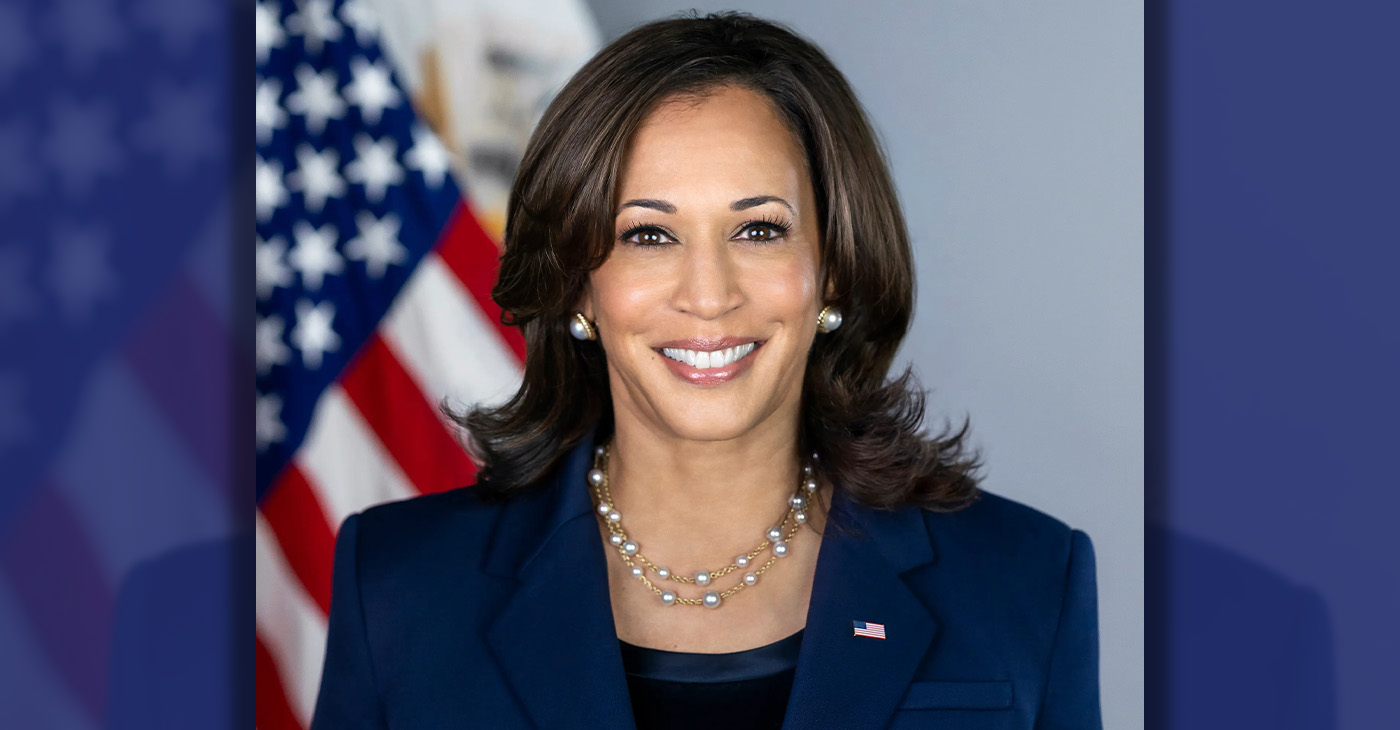
By California Black Media
Speaking in Las Vegas on Jan. 27, Vice President Kamala Harris announced a forthcoming federal rule that will extend access to Small Business Administration (SBA) loans to Americans who have been convicted of felonies but have served their time.
Small business owners typically apply for the SBA loans to start or sustain their businesses.
Harris thanked U.S. Rep. Steven Horsford (D-NV-04), the chair of the Congressional Black Caucus, for the work he has done in Washington to support small businesses and to invest in people.
“He and I spent some time this afternoon with business leaders and small business leaders here in Nevada. The work you have been doing to invest in community and to invest in the ambition and natural capacity of communities has been exceptional,” Harris said, speaking to a crowd of a few hundred people at the Brotherhood of Electrical Workers Hall in East Las Vegas.
On her daylong trip, Harris was joined by Horford, SBA Administrator Isabella Guzman, Interim Under Secretary of Commerce for Minority Business Development Agency (MBDA) Eric Morrissette, and Sen. Catherine Cortez Masto (D-Nev).
“Formerly incarcerated individuals face significant barriers to economic opportunity once they leave prison and return to the community, with an unemployment rate among the population of more than 27%,” the White House press release continued. “Today’s announcement builds on the Vice President’s work to increase access to capital. Research finds that entrepreneurship can reduce recidivism for unemployed formerly incarcerated individuals by as much as 30%.”
Business
G.O.P. Lawmakers: Repeal AB 5 and Resist Nationalization of “Disastrous” Contractor Law
Republican lawmakers gathered outside of the Employee Development Department in Sacramento on Jan. 23 to call for the repeal of AB5, the five-year old California law that reclassified gig workers and other independent contractors as W-2 employees under the state’s labor code.

By California Black Media
Republican lawmakers gathered outside of the Employee Development Department in Sacramento on Jan. 23 to call for the repeal of AB5, the five-year old California law that reclassified gig workers and other independent contractors as W-2 employees under the state’s labor code.
Organizers said they also held the rally to push back against current efforts in Washington to pass a similar federal law.
“We are here to talk about this very important issue – a battle we have fought for many years – to stop this disastrous AB 5 policy,” said Assembly Republican Leader James Gallagher (R-Yuba City).
Now, that threat has gone national as we have seen this new rule being pushed out of the Biden administration,” Gallagher continued.
On Jan. 10, the U.S. Department of Labor issued a new rule providing guidance on “on how to analyze who is an employee or independent contractor under the Fair Labor Standards Act (FLSA).”
“This final rule rescinds the Independent Contractor Status Under the Fair Labor Standards Act rule (2021 IC Rule), that was published on January 7, 2021, and replaces it with an analysis for determining employee or independent contractor status that is more consistent with the FLSA as interpreted by longstanding judicial precedent,” a Department of Labor statement reads.
U.S. Congressmember Kevin Kiley (R-CA-3), who is a former California Assemblymember, spoke at the rally.
“We are here today to warn against the nationalization of one of the worst laws that has ever been passed in California, which has devastated the livelihoods of folks in over 600 professions,” said Kiley, adding that the law has led to a 10.5% decline in self-employment in California.
Kiley blamed U.S Acting Secretary of Labor, July Su, who was the former secretary of the California Labor and Workforce Development Agency, for leading the effort to redefine “contract workers” at the federal level.
Kiley said two separate lawsuits have been filed against Su’s Rule – its constitutionality and the way it was enacted, respectively. He said he is also working on legislation in Congress that puts restrictions on the creation and implementation of executive branch decisions like Su’s.
Assemblymember Kate Sanchez (R-Rancho Santa Margarita) announced that she plans to introduce legislation to repeal AB 5 during the current legislative session.
“So many working moms like myself, who are also raising kids, managing households, were devastated by the effects of AB 5 because they lost access to hundreds of flexible professions,” Sanchez continued. “I’ve been told by many of these women that they have lost their livelihoods as bookkeepers, artists, family caregivers, designers, and hairstylists because of this destructive law.”
Activism
Oakland Post: Week of April 10 – 16, 2024
The printed Weekly Edition of the Oakland Post: Week of April 10 – 16, 2024
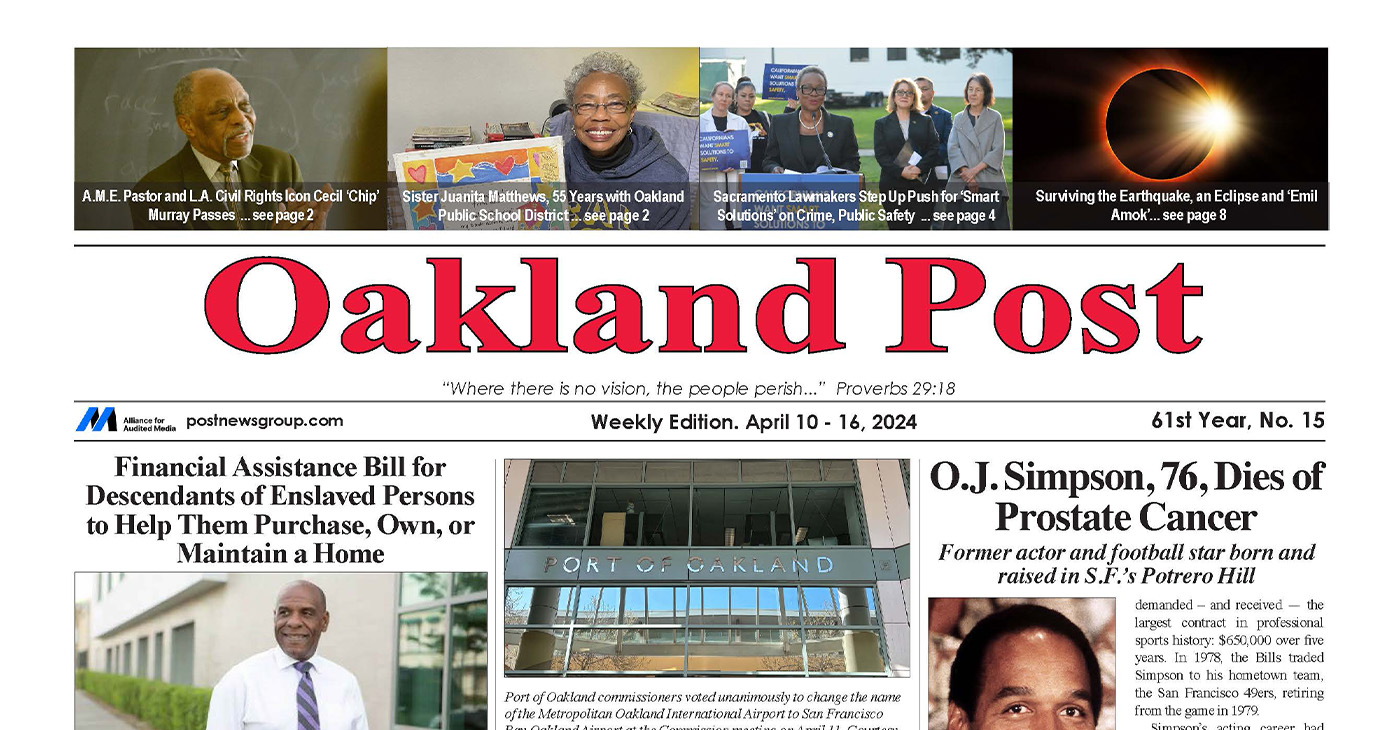
To enlarge your view of this issue, use the slider, magnifying glass icon or full page icon in the lower right corner of the browser window. ![]()
-

 Activism4 weeks ago
Activism4 weeks agoOakland Post: Week of March 20 – 26, 2024
-

 #NNPA BlackPress3 weeks ago
#NNPA BlackPress3 weeks agoMayor, City Council President React to May 31 Closing of Birmingham-Southern College
-

 #NNPA BlackPress3 weeks ago
#NNPA BlackPress3 weeks agoCOMMENTARY: D.C. Crime Bill Fails to Address Root Causes of Violence and Incarceration
-

 #NNPA BlackPress3 weeks ago
#NNPA BlackPress3 weeks agoFrom Raids to Revelations: The Dark Turn in Sean ‘Diddy’ Combs’ Saga
-

 #NNPA BlackPress3 weeks ago
#NNPA BlackPress3 weeks agoCOMMENTARY: Lady Day and The Lights!
-

 #NNPA BlackPress3 weeks ago
#NNPA BlackPress3 weeks agoBaltimore Key Bridge Catastrophe: A City’s Heartbreak and a Nation’s Alarm
-

 #NNPA BlackPress3 weeks ago
#NNPA BlackPress3 weeks agoBaltimore’s Key Bridge Struck by Ship, Collapses into Water
-

 Activism3 weeks ago
Activism3 weeks agoOakland Post: Week of March 27 – April 2, 2024

